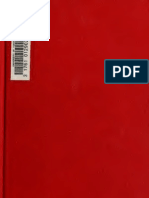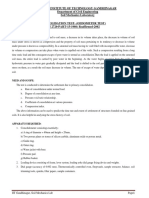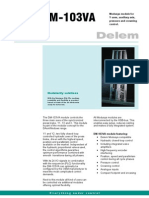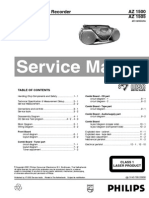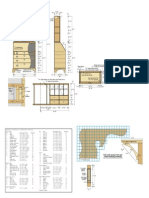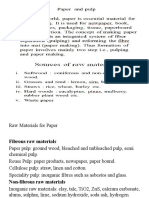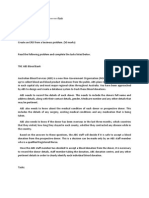Professional Documents
Culture Documents
The Effect of Land Use On The Road's Level of Service in Lawang - Singosari Road Due To The Construction of Malang - Pandaan Toll Road
Uploaded by
Anonymous izrFWiQOriginal Title
Copyright
Available Formats
Share this document
Did you find this document useful?
Is this content inappropriate?
Report this DocumentCopyright:
Available Formats
The Effect of Land Use On The Road's Level of Service in Lawang - Singosari Road Due To The Construction of Malang - Pandaan Toll Road
Uploaded by
Anonymous izrFWiQCopyright:
Available Formats
Volume 4, Issue 5, May– 2019 International Journal of Innovative Science and Research Technology
ISSN No:-2456-2165
The Effect of Land Use on the Road’s Level of
Service In Lawang – Singosari Road Due to the
Construction of Malang – Pandaan Toll Road
Wahyu Ramadhan Budi Sugiarto Waloejo
Student, Department of Urban and Regional Planning Lecture, Department of Urban and Regional Planning
Faculty of Engineering, Brawijaya University Faculty of Engineering, Brawijaya University
Malang, Indonesia Malang, Indonesia
Imma Widyawati Agustin
Lecture, Department of Urban and Regional Planning
Faculty of Engineering, Brawijaya University
Malang, Indonesia
Abstract:- The uncontrolled development of land use maintain traveled distance (Rahayu, 2016). The growth of
and the increasing of intercity transportation’s the transportation network cannot balance the economic
movement in the main corridor cause the decreasing growth and land use makes overcapacity exists. The
road’s level of service in Lawang – Singosari Street. The intensity of land use's activities which is increasing, push
policy of Malang – Pandaan toll road development is the increasing of the volume of transportation too which
expected to be able to decrease the congestion on the affects more in the traveled distance to cause a traffic jam.
artery road. The aim of this study is to count the impact The policy of the development of Malang – Pandaan Toll
of land use in the road’s level of service on Lawang – Road was done to maintain travel distance and increase
Singosari street. The vehicle's movement from the land accessibility.
use's activities is analyzed using multiple linear
regression, meanwhile, the analysis method used for the II. METHODOLOGY
movement of continuous traffic and branching road is
traffic flow and traffic diversion curve analysis. The This study uses the interaction between transportation
result of this study shows the contribution of the subsystem concepts which is land use activity and network
attraction and generation volume of movement due to system which these interactions will produce movement
33.5% of land use. The development of Malang – system. This study is descriptive study using a quantitative
Pandaan toll road affects to the volume of the approach so it can measure the effect from land use’s
continuous traffic which is diverse through the toll road variable and the development of Malang – Pandaan Road
that reaches 61% and causes the increasing Toll statistically towards the level of service in Lawang –
contribution of the attraction and generation volume of Singosari Street. The methodologies of this study consist
land use due to 50.1%. of:
Keywords:- Movement Model; Land Use; Road’s Level of A. Research Variable
Service; Toll Road. Variable and sub-variable in this study are determined
based on the aim of the study through related theories and
I. INTRODUCTION previous studies. The variables of the study are including:
In a developing country, the increasing of intercity 1) Road Capacity
transportations that are dominated by private vehicles and Variable of the road capacity consists of several sub-
less public transportation support and the policy of land use variables: road geometric, flow composition and road
can cause congestion (Fatemeh Salarvandian, 2017). The separator, sideways roadblock, and traffic regulation.
decreasing of function and road capacity is because of the
traffic volume in the attraction and generation especially in 2) Traffic Flow
trading and service (Waloejo, Surjono, & Sulistio, 2012). Variable of the traffic low consists of several sub-
The development of trading and service area in the main variables: external traffic flow (consistent flow and
corridor can give effect towards the road's level of service branching road flow) and internal traffic flow.
(Agustin, 2017). The integration of street modeling and
land use becomes the tools to estimate land use’s pattern 3) Attraction and Generation Modelling of Land Use
and the increasing of traffic volume in the future Variable of generation models and land use consist of
(Mohammad Tayarani, 2018). The increasing road capacity sub-variables: generation of land use movements and
and the formation of a new road can be several solutions to attraction of land use movements.
IJISRT19MY636 www.ijisrt.com 897
Volume 4, Issue 5, May– 2019 International Journal of Innovative Science and Research Technology
ISSN No:-2456-2165
4) Traffic Diversion C. Data Analysis
Traffic diversion variable consists of several sub- ATA analysis in this study uses evaluative analysis.
variables: external traffic flow (continuous traffic), distance The results of the analysis are as follows:
(the length of the road), and traveled distance.
1) The Analysis of Road’s Level of service
B. Data Collecting This analysis is done by comparing the capacities of
The method of data collecting is done through the road towards the volume of the vehicle which passes on
primary and secondary surveys. The researcher of this it so the researcher can get the road's level of service.
study elaborates the method for every variable and sub-
variable as follows: 2) Road Capacity
The analysis of road capacity is done to count the
1) Road Capacity level of the road’s ability to accommodate the traffic flow
The variable of road capacity is done by field by measuring the basic capacity, adjustment factor of the
observation through measuring the road geometric, the road’s width, adjustment factor of the sideways’ width,
volume of the vehicle, and sideways roadblock in the street flow composition and direction separator, sideways
of the study. roadblock, and the city’s size as well as the traffic
regulation.
2) Traffic Flow
The variable of vehicle traffic flow is done by field 3) Traffic Flow
observation by measuring the vehicles. The internal flow The analysis of traffic flow is an analysis to count the
measuring is by counting the vehicles that were in and out volume of the vehicle that passes through a certain road.
in the land use. Meanwhile, the continuous traffic flow uses This analysis is used to find out the average daily traffic.
plat matching technique and external flow (branching road)
through the counting of the vehicles that were in and out in 4) Analysis of Correlation and Linear Regression
the main branching road. The correlation analysis is the analysis to find out the
level of the relationship between land use’s characteristics
3) Attraction and Generation Modelling of Land Use and internal volume traffic. Meanwhile, analysis double
The variable of attraction and generation modeling of linear regression in this study is used stepwise methods;
land use is done by field observation by identifying the this analysis is used to compose the best equation of the
type of land use and vehicle's volume measurement due to characteristic effects of land use towards the movement
land use. Meanwhile, the data collecting is from a related from the land use.
questionnaire about the characteristic condition of land use
that can affect the attraction and generation in it. 5) Traffic Diversion (Diversion Curve)
The measurement of vehicle diversion values in this
4) Traffic Diversion study uses diversion curve of travel time and distance
The variable of traffic diversion is done by field saving between the main road of Lawang – Singosari and
observation through continuous traffic measurement using Malang – Pandaan Toll Road.
plat matching technique and also the margin of distance
and traveled distance between Artery Street and the toll
road.
Capacity of Road
- Basic capacity Road s Road s Level of
- factor for direction separation Road Capacity Level of Service on Lawang -
- Effective Road Width Analysis Service Singosari Street
- Side Obstacle Conditions Analysis before the Malang -
- Total Population Pandaan Toll Road
Traffic Flow Road s Level of
- Internal volume Traffic Flow Service on Lawang
- External volume Analysis - Singosari Street
After the Malang -
Characteristics of Toll Roads Analysis of Pandaan Toll Road
- Length of Road Continuous Flow
- Traveling time Diversion across
Effect of Generation
- Plan for Traffic Schemes the Toll Road
and Attraction Land
Use on Road s Level of
service Before and
Variable from Land Use
After Toll Roads
Number of Kend Ownership.
Generation /
Number of floors Analysis of
Correlation Attraction
Number of employees Multiple Linear
Analysis Modelling for
Parking area Regression
land use
Building area
Etc ...
Fig 1:- Framework of research methods
IJISRT19MY636 www.ijisrt.com 898
Volume 4, Issue 5, May– 2019 International Journal of Innovative Science and Research Technology
ISSN No:-2456-2165
HIGHWAY
Veksternal-4
Veksternal-4
OPERATIONAL
Branching
EXISTING
Branching
INTERACTION
Road
INTERACTION V1 V2 V3 V4 V1 V2 V3 V4
Road
SCHEMES
SCHEME
Veksternal 1 – Veksternal 2 –
Veksternal-1 Main Road Veksternal-2 (Ptol x Veksternal 1) Main road (Ptol x Veksternal 2)
V5 V6 V5 V6
Veksternal-3 Veksternal-3
CONTINUOUS FLOW FLOW DIVERSION
WAS TOLL ROAD
Fig 2:- Research concept (Waloejo, 2013)
In order to find out the interaction modeling between
land use and road network, the formula that is used is
(Waloejo, 2013) :
VTotal = ∑ Vinternal + ∑ Veksternal (1
)
where :
∑ Vtotal = Total volume of vehicle’s movement/ hour on the
main road corridor
∑ Vinternal = Total volume of the vehicle's movement/hour
from the whole attraction and generation of land use
∑ Vexternal = Total volume of the vehicle's movement from
the movement of the environment road volume and the
continuous traffic on the main road.
So, to count the road’s level of service (PKJI, 2014),
the formula used is based on the model interaction as
follows:
𝐕 𝐭𝐨𝐭𝐚𝐥 (𝐩𝐜𝐮/𝐡𝐨𝐮𝐫)
Road’s Level of Service (DJ) = (2
𝐂 (𝐩𝐜𝐮/𝐡𝐨𝐮𝐫)
)
where Vtotal is the vehicle/hour movement volume
which is on the corridor of the main street and C is the
road’s level of service.
III. RESULT
The location of this study is on the main road of
Lawang – Singosari. The road network in that road is
including in the national category of the road with the
hierarchy as primer artery since it connects Malang and
Surabaya. The location image of the study and the segment
division on the road will be presented as follow.
Fig 3:- Research Location Mapping on Lawang – Singosari
Street
IJISRT19MY636 www.ijisrt.com 899
Volume 4, Issue 5, May– 2019 International Journal of Innovative Science and Research Technology
ISSN No:-2456-2165
This land uses along the main road of Lawang – a. Mechanic Shop and Buying/Selling Vehicles
Singosari. They are including: Based on the result of the analysis, the equation
drawn from it is Y = 0.863 + 0.401 (building area) + 0.549
No Type of Land use Population (number of the visitor) with the land use’s characteristics
average around 63.3 m2 and the number of the visitors are
1 Housing 65 around 54 people.
2 Trading and Service 320
Mechanic Shop and b. Supermarket
1 48
Buying/Selling Vehicles Based on the result of the analysis, the equation
2 Supermarket 17 drawn from it is Y = - 0.443 + 0.403 (parking lot area) +
3 Printing and Convection Service 16 0.357 (building area) + 0.323 (number of the visitor) with
4 Cafe and Restaurant 22 the land use’s characteristics average around 74 m2, 108.7
5 Daily Needs Shop 39 m2 for the building area and 191 visitors.
6 Clothing and Accessories Shop 16
7 Handphone and Credit Shop 17 c. Printing and Convection Service
8 Small Shop 70 Based on the result of the analysis, the equation
The building, Furnishing, and drawn from it is Y = 2.907 + 0.415 (parking lot area ) +
9 45
Electronic Shop 0.822 (number of the visitor) with the land use’s
10 Gas Station 2 characteristics average is 42.6 m2 for the parking lot area
11 Other Trading and Service 28 and 49 visitors.
3 Education 8
4 Officce 36 d. Cafe and Restaurant
5 Worship Place 4 Based on the result of the analysis, the equation
6 Industry and Warehouse 29 drawn from it is Y = - 7.501 + 0.677 (parking lot area) +
7 Health 17 0.466 (number of the visitor) with the land use’s
Total 479 characteristics average is 63 m2 for the parking lot area and
Empty Building 65 120 visitors.
Table 1:- Type Identification of Land Use
e. Daily Needs Shop
Based on Table 1, the dominating land use in the area Based on the result of the analysis, the equation
of the study is trading and service with total amoung 67% drawn from it is Y = - 20.532 + 0.735 (building area) +
and 14% for housing so the effect of land use towards the 0.423 (number of the visitor) with the land use’s
road’s level of service will focus more on that land use. characteristics average is 64.7 m2 for the building area and
203 visitors.
A. Road Capacity
The main road of Lawang – Singosari has the basic f. Clothing and Accessories Shop
capacity (Co) with the total amount of 6.600 pcu/hour, the Based on the result of the analysis, the equation
value of capacity adjustment factor for direction separation drawn from it is Y = - 30.755 + 0.795 (building area) +
(FCPA) is 1. Meanwhile, the value of capacity adjustment 0.498 (number of the visitors) with the land use’s
for sideways roadblock (FCHS) is 0.96 and the value of characteristics average is 72.7 m2 for the building area
capacity adjustment for lanes' width/traffic lanes (FCLJ) is (X35) and 170 visitors (X36).
0,96. Last but not least, the capacity adjustment factor for
the city size (FCUK) is 1 so it can be drawn that the capacity g. Handphone and Credit Shop
on Lawang – Singosari Street is 6.209 pcu/hour. Based on the result of the analysis, the equation
drawn from it is Y = 21.873 + 1.484 (parking lot area) +
B. Attraction and Generation of Land Use Modelling 0.133 (number of the visitors) with the land use’s
characteristics average is 22.6 m2 for the parking lot area
1) Land Use Housing and 91 visitors.
Based on the result of the analysis, the model shown
from the result with the equation Y = 1.208 + 0.023 h. Small Shop
(building area) + 0.407 (the number of family members) + Based on the result of the analysis, the equation
0.335 (vehicle ownership) with the average land use’s drawn from it is Y = 2.628 + 0.687 (building area) + 0.130
characteristic, the building area is 66.37 m2. On the other (number of the visitors) with the land use’s characteristics
hand, the number of family members is 4 people and the average is 39.6 m2 for the building area and 96 visitors.
number of vehicle ownership is 4 units.
i. The building, Furnishing, and Electronic Shop
2) Land Use Trading and Service Based on the result of the analysis, the equation
Based on the result of double linear regression drawn from it is Y = - 21.423 + 0.272 (building area) +
analysis, there is attraction movement modeling in the 0.816 (number of the visitors) with the land use’s
trading and service land use. The several types of that characteristics average is 75 m2 for the building area and
modeling based on the activities are as follow: 163 visitors.
IJISRT19MY636 www.ijisrt.com 900
Volume 4, Issue 5, May– 2019 International Journal of Innovative Science and Research Technology
ISSN No:-2456-2165
j. Gas Station
Based on the result of the analysis, the equation b. Drug Store / Clinic
drawn from it is Y = - 3.255 + 12.867 (building area) with Based on the previous study, the equation drawn
the land use’s characteristics average is 230 m2 for the from it is Y = - 11.700 + 1.501 (number of the visitor) +
building area. 0.114 (building area) with the land use’s characteristics
average is 33 visitors and 108 m2 for the building area.
k. Other Trading and Service
Based on the result of the analysis, the equation Here is the recapitulation of attraction and generation
drawn from it is Y = - 30.860 + 0.300 (building area) + land use modeling's application along the main road of
0.708 (number of traffic) with the land use’s characteristics Lawang – Singosari.
average is 81 m2 for the building area and 145 visitors.
3) Land Use Office
Based on the previous study, the equation drawn
from it is Y = - 64.733 + 1.257 (building area) + 0.240
(number of the visitor) with the land use’s characteristics
average is 586 m2 for the building area and 45 visitors.
4) Land Use Education
Based on the previous study, the equation drawn
from it is Y = - 8.762 + 0.111 (number of the student) +
0.163 (building area) with the land use’s characteristics
average is 842.6 m2 for the building area. Meanwhile, there
are 321 students.
5) Industry and Warehouse Land Use
Based on the previous study, the equation drawn Fig 4:- Graph of Application of Vehicle Movement Model
from it is Y = - 5.104 + 0.736 (number of the employee) + due to Land Use on Lawang – Singosari Street
1.832 (delivery frequency) with the land use’s
characteristics average is 56 employees and the delivery Based on figure 4, it can be seen that the biggest land
frequency is 18 delivery in a day. use vehicle's movement modeling that attraction or
generation the movement is land use trading and service
6) Land Use Public Health which is 32696.5 pcu/day. The second biggest land use is
Based on the previous study, there is attraction from the office which is 4613.47 pcu/day. The least land
movement modeling in health land use. The several types use movement modeling that attracts the movement in
of that modeling based on the activities are as follow: place of public worship which is only 276.5 pcu/day.
a. Hospital or Health Center C. External Traffic Flow (Continuous Traffic)
Based on the previous study, the equation drawn The measurement of traffic flow is done to find out
from it is Y = - 2.354 + 0.360 (number of the daily the vehicle's movement that has traveled continuously in
patient) + 0.038 (inpatient room area) with the land use’s every segment. Here is the continuous traffic flow on
characteristics average is 220 patients and 625 m2 for the Lawang – Singosari Street.
inpatient room area.
Continuous Volume (unit)
Time Total of continuous volume (pcu/hour)
MC LV HV
06.00 - 07.00 6126 2513 323 4432.1
07.00 - 08.00 5632 2580 310 4360
08.00 - 09.00 4772 2486 269 4001.8
09.00 - 10.00 2509 2178 247 3101.65
14.00 - 15.00 3141 2124 267 3229.65
15.00 - 16.00 3023 2530 273 3613.35
16.00 - 17.00 3571 2226 259 3429.55
17.00 - 18.00 4823 2444 367 4090.15
18.00 - 19.00 4384 2318 349 3832.8
Total 37981 21399 2664 34091.05
Table 2:- Continuous Traffic Volume on Lawang - Singosari Street
IJISRT19MY636 www.ijisrt.com 901
Volume 4, Issue 5, May– 2019 International Journal of Innovative Science and Research Technology
ISSN No:-2456-2165
Based on Table 2, the volume of the continuous people who go to school or office along on Lawang –
traffic on Lawang – Singosari street that facing the density Singosari Street. It can also because of the intercity
of vehicles is in the morning starts from 06.00 – 07.00 am. movement through that road.
The vehicle's volume is around 4432.1 pcu/hour. On the
other hand, the volume of the vehicle in the afternoon D. External Traffic Flow (Branching Road)
starts from 5.00 – 6.00 pm is 4090.15 pcu/hour. The The total vehicle’s volume on the whole branching
indication of this event is caused by the movement of road especially is analyzed every hour.
Time Branching road Volume (pcu/hour)
06.00 - 07.00 302.6
07.00 - 08.00 322.1
08.00 - 09.00 281.45
09.00 - 10.00 294.85
14.00 - 15.00 258.2
15.00 - 16.00 269.7
16.00 - 17.00 309.5
17.00 - 18.00 350.65
18.00 - 19.00 372
Total 2761.05
Table 3:- Branching Road Traffic Volume On Lawang – Singosari Street
Based on Table 3, the traffic’s volume of branching E. The Effect of Land Use towards Road’s Level of Service
road on Lawang – Singosari Street faces its rush hour in before the Development of Malang – Pandaan Toll Road
the morning starts from 07.00 – 08.00 am and 05.00 – Based on the result of the capacity measurement and
08.00 pm in the afternoon. traffic flow volume on Lawang – Singosari Street, it can be
concluded that the result of the road’s level of service and
the effect of land use on that main road before the
development of the toll road is as follows:
Time Total Volume (pcu/hour) Volume of Land use (pcu/hour) DJ LOS Effect of Land Use (%)
06.00 - 07.00 5141.29 406.59 0.83 D 7.9
07.00 - 08.00 5894.87 1212.77 0.95 E 20.6
08.00 - 09.00 6109.19 1825.94 0.98 E 29.9
09.00 - 10.00 5173.58 1777.08 0.83 D 34.3
14.00 - 15.00 5235.25 1747.40 0.84 D 33.4
15.00 - 16.00 5521.81 1638.76 0.89 E 29.7
16.00 - 17.00 5515.25 1776.20 0.89 E 32.2
17.00 - 18.00 5896.59 1455.79 0.95 E 24.7
18.00 - 19.00 5109.93 905.13 0.82 D 17.7
Table 4:- Road Level of Service and Effect of Land Use on Lawang Singosari Street
Fig 5:- Graph of comparison of attraction and generation volume of land use, total volume and capacity of road
IJISRT19MY636 www.ijisrt.com 902
Volume 4, Issue 5, May– 2019 International Journal of Innovative Science and Research Technology
ISSN No:-2456-2165
Based on Table 5, it can be seen that the vehicle’s happens in the afternoon starts from 04.00 – 05.00 pm. It is
movement due to land use towards the total vehicle volume happened because of the high intensity of people's activities
in every segment on Lawang – Singosari Street before the in trading and service aspects in the morning till afternoon.
operational hour of Malang – Pandaan Toll Road has
percentage around 7.9 – 34.3% with different contribution F. Continuous Traffic Flow Diversion
in every hour of observation. This study uses diversion curve to determine the
estimation of separation traffic that chooses Malang –
It shows that before the toll road was opened, the Pandaan Toll Road and traffic that is left behind through on
contribution of external traffic flow (continuous traffic) was Lawang – Singosari Street. This curve uses the variable
more dominating compared to local flow (land use). On that consists of the difference between distance and traveled
segment 1, the biggest volume contribution due to land use distance between vehicle’s movements which go through
happens in the morning starts from 09.00 – 10.00 am is the main road of Simpang Karanglo – Purwodadi Toll Gate
34.3%. Meanwhile, the volume percentage around 32.2% and those vehicles on the Karanglo – Purwodadi Toll Road.
Time Difference in Travel Time (minutes) difference in distance (km) Flow Diversion (%)
06.00 - 07.00 6.1 -3.5 47%
07.00 - 08.00 10.2 -3.5 58%
08.00 - 09.00 10.2 -3.5 58%
09.00 - 10.00 7.5 -3.5 52%
14.00 - 15.00 6.1 -3.5 47%
15.00 - 16.00 7.5 -3.5 52%
16.00 - 17.00 9.2 -3.5 56%
58%
17.00 - 18.00 10.2 -3.5
18.00 - 19.00 6.1 -3.5 47%
Table 5:- Diversion Flows On Karanglo - Purwodadi Main Road And Karanglo - Tol Purwodadi Toll Road
Based on the picture above, the traffic flow diversion G. The Effect of Land Use towards Road’sLevel of service
that is predicted will go through Malang – Pandaan Toll after the Development of the Toll Road
Road is 47% – 58%. Based on the counting of traffic flow diversion, the
road’s capacity and traffic flow volume on Lawang –
Singosari Street, the result of the road’s level of service
and the effect of land use on that road after the
development of the toll road are as follows:
Effect of Land Use
Time Total Volume (pcu/hour) Volume of Land use (pcu/hour) DJ LOS (%)
06.00 - 07.00 3777.99 406.59 0.61 C 10.8
07.00 - 08.00 4182.67 1212.77 0.67 C 29.0
08.00 - 09.00 4480.09 1825.94 0.72 C 40.8
09.00 - 10.00 3886.93 1777.08 0.63 C 45.7
14.00 - 15.00 4086.40 1747.40 0.66 C 42.8
15.00 - 16.00 4035.86 1638.76 0.65 C 40.6
16.00 - 17.00 4094.60 1776.20 0.66 C 43.4
17.00 - 18.00 4223.64 1455.79 0.68 C 34.5
18.00 - 19.00 3823.63 905.13 0.62 C 23.7
Table 6:- Road’s Level of Service and Effect of Land Use on Lawang Singosari Street
IJISRT19MY636 www.ijisrt.com 903
Volume 4, Issue 5, May– 2019 International Journal of Innovative Science and Research Technology
ISSN No:-2456-2165
REFERENCES
[1]. Agustin, Imma. W. (2017). Influence of food kiosk
attraction on the road’s level of service. The 4th
International Seminar on Sustainable Urban
Development (p. 106). Malang: IOP Conference
Series: Earth and Environmental Science.
[2]. Budi S. Waloejo, Surjono & Harnen Sulistio. (2012).
The Influence of Trip Attraction on the Road’s Level
of Service (LOS) at Traditional Market Land Use.
Journal of Applied Environmental and Biological
Sciences, J. Appl. Environ. Biol. Sci., 2(1)92-96.
[3]. Fatemeh Salarvandian, M. D. (2017). Impact of traffic
zones on mobility behavior in Tehran. Journal of
Fig 6:- Graph of comparison of attraction and generation Transport and Land Use, Vol. 10, No. 1, pp. 965-982.
volume of land use, total volume and capacity of road [4]. Merlin, L. A. (2017). A portrait of accessibility change
for four US metropolitan areas. The Journal Of
According to Table 6, it can be seen the vehicle’s Transport And Land Use, Vol. 10 pp. 309-336.
movement due to land use towards the total volume of [5]. Mohammad Tayarani, R. N. (2018). Evaluating the
whole vehicles in every segment on Lawang – Singosari cumulative impacts of a long range
Street after the toll road was opened is 10.8% - 45.7% with regionaltransportation plan: Particulate matter
different effect contribution in every hour of observation. It exposure, greenhouse gasemissions, and transportation
shows that after the toll road of Malang – Pandaan was system performance. Serial : Transportation Research
opened, the contribution of internal traffic flow (land use) Part D, Transport and Environment Journal, Vol. 63
is almost balance compared to external traffic flow No. 261-275.
(continuous traffic) and it is bigger than before. On [6]. PKJI. (2014). Pedoman Kapasitas Jalan Indonesia
segment 1, the biggest contribution volume of land use (PKJI). Departemen Pekerjaan Umum Direktorat
happens in the morning starts from 09.00 – 10.00 am Jenderal Bina Marga.
which is 45.7% and 43.4% in the afternoon starts from [7]. Rahayu, Y. E. (2016). Land use development and its
04.00 – 05.00 pm. It is happened because of the high impact on airport access road. Procedia - Social and
intensity of people's activities in trading and service Behavioral Sciences, Vol 227, No 31 – 37.
aspects in the morning till afternoon. [8]. Waloejo, Budi S. (2013). Model Interaksi Tata Guna
Lahan dan Jaringan Jalan. Malang: Disertasi
IV. CONCLUSION
The conclusions of this study about “the effect of
land use and the development of Malang – Pandaan Toll
Road” are as follows:
1. The effect of land use towards the road’s level of
service before Malang – Pandaan Toll Road was
opened is 7.9% - 34.3%. It shows that the external
traffic flow (continuous traffic) contribution is more
dominating than local flow (land use).
2. The impact of Malang – Pandaan Toll Road’s
development can diverse the continuous traffic flow
around 47% - 61%.
The effect of land use towards road’s level of service
after Malang – Pandaan Toll Road was opened is around
10.8% - 45.7%. It shows that the external traffic flow
(continuous traffic) contribution is more dominating than
local flow (land use).
IJISRT19MY636 www.ijisrt.com 904
You might also like
- The Sympathizer: A Novel (Pulitzer Prize for Fiction)From EverandThe Sympathizer: A Novel (Pulitzer Prize for Fiction)Rating: 4.5 out of 5 stars4.5/5 (119)
- Devil in the Grove: Thurgood Marshall, the Groveland Boys, and the Dawn of a New AmericaFrom EverandDevil in the Grove: Thurgood Marshall, the Groveland Boys, and the Dawn of a New AmericaRating: 4.5 out of 5 stars4.5/5 (266)
- A Heartbreaking Work Of Staggering Genius: A Memoir Based on a True StoryFrom EverandA Heartbreaking Work Of Staggering Genius: A Memoir Based on a True StoryRating: 3.5 out of 5 stars3.5/5 (231)
- Grit: The Power of Passion and PerseveranceFrom EverandGrit: The Power of Passion and PerseveranceRating: 4 out of 5 stars4/5 (588)
- The Little Book of Hygge: Danish Secrets to Happy LivingFrom EverandThe Little Book of Hygge: Danish Secrets to Happy LivingRating: 3.5 out of 5 stars3.5/5 (399)
- Never Split the Difference: Negotiating As If Your Life Depended On ItFrom EverandNever Split the Difference: Negotiating As If Your Life Depended On ItRating: 4.5 out of 5 stars4.5/5 (838)
- The Subtle Art of Not Giving a F*ck: A Counterintuitive Approach to Living a Good LifeFrom EverandThe Subtle Art of Not Giving a F*ck: A Counterintuitive Approach to Living a Good LifeRating: 4 out of 5 stars4/5 (5794)
- The Emperor of All Maladies: A Biography of CancerFrom EverandThe Emperor of All Maladies: A Biography of CancerRating: 4.5 out of 5 stars4.5/5 (271)
- The World Is Flat 3.0: A Brief History of the Twenty-first CenturyFrom EverandThe World Is Flat 3.0: A Brief History of the Twenty-first CenturyRating: 3.5 out of 5 stars3.5/5 (2219)
- Shoe Dog: A Memoir by the Creator of NikeFrom EverandShoe Dog: A Memoir by the Creator of NikeRating: 4.5 out of 5 stars4.5/5 (537)
- Team of Rivals: The Political Genius of Abraham LincolnFrom EverandTeam of Rivals: The Political Genius of Abraham LincolnRating: 4.5 out of 5 stars4.5/5 (234)
- The Hard Thing About Hard Things: Building a Business When There Are No Easy AnswersFrom EverandThe Hard Thing About Hard Things: Building a Business When There Are No Easy AnswersRating: 4.5 out of 5 stars4.5/5 (344)
- The Gifts of Imperfection: Let Go of Who You Think You're Supposed to Be and Embrace Who You AreFrom EverandThe Gifts of Imperfection: Let Go of Who You Think You're Supposed to Be and Embrace Who You AreRating: 4 out of 5 stars4/5 (1090)
- Her Body and Other Parties: StoriesFrom EverandHer Body and Other Parties: StoriesRating: 4 out of 5 stars4/5 (821)
- Elon Musk: Tesla, SpaceX, and the Quest for a Fantastic FutureFrom EverandElon Musk: Tesla, SpaceX, and the Quest for a Fantastic FutureRating: 4.5 out of 5 stars4.5/5 (474)
- Hidden Figures: The American Dream and the Untold Story of the Black Women Mathematicians Who Helped Win the Space RaceFrom EverandHidden Figures: The American Dream and the Untold Story of the Black Women Mathematicians Who Helped Win the Space RaceRating: 4 out of 5 stars4/5 (895)
- The Unwinding: An Inner History of the New AmericaFrom EverandThe Unwinding: An Inner History of the New AmericaRating: 4 out of 5 stars4/5 (45)
- The Yellow House: A Memoir (2019 National Book Award Winner)From EverandThe Yellow House: A Memoir (2019 National Book Award Winner)Rating: 4 out of 5 stars4/5 (98)
- On Fire: The (Burning) Case for a Green New DealFrom EverandOn Fire: The (Burning) Case for a Green New DealRating: 4 out of 5 stars4/5 (73)
- John Wilson - Lost Solar System of The Ancient (Vol 2)Document522 pagesJohn Wilson - Lost Solar System of The Ancient (Vol 2)Rajat K Bose100% (2)
- Platelet-Rich Plasma in Orthodontics - A ReviewDocument6 pagesPlatelet-Rich Plasma in Orthodontics - A ReviewAnonymous izrFWiQNo ratings yet
- Pharmaceutical Waste Management in Private Pharmacies of Kaski District, NepalDocument23 pagesPharmaceutical Waste Management in Private Pharmacies of Kaski District, NepalAnonymous izrFWiQNo ratings yet
- REV Description Date Originated BY Checked BY Approved BY: 01B IFR - Issued For ReviewDocument10 pagesREV Description Date Originated BY Checked BY Approved BY: 01B IFR - Issued For ReviewAbdur RehmanNo ratings yet
- Scientific Design of Bamboo Structures for Rural DevelopmentDocument37 pagesScientific Design of Bamboo Structures for Rural Developmentniravhirpara67% (3)
- Basic Principles of PropulsionDocument45 pagesBasic Principles of PropulsionEverson VieiraNo ratings yet
- Teacher Leaders' Experience in The Shared Leadership ModelDocument4 pagesTeacher Leaders' Experience in The Shared Leadership ModelAnonymous izrFWiQNo ratings yet
- Evaluation of Assessing The Purity of Sesame Oil Available in Markets of India Using Bellier Turbidity Temperature Test (BTTT)Document4 pagesEvaluation of Assessing The Purity of Sesame Oil Available in Markets of India Using Bellier Turbidity Temperature Test (BTTT)Anonymous izrFWiQNo ratings yet
- Bioadhesive Inserts of Prednisolone Acetate For Postoperative Management of Cataract - Development and EvaluationDocument8 pagesBioadhesive Inserts of Prednisolone Acetate For Postoperative Management of Cataract - Development and EvaluationAnonymous izrFWiQNo ratings yet
- Analysis of Ancol Beach Object Development Using Business Model Canvas ApproachDocument8 pagesAnalysis of Ancol Beach Object Development Using Business Model Canvas ApproachAnonymous izrFWiQNo ratings yet
- Investigations On BTTT As Qualitative Tool For Identification of Different Brands of Groundnut Oils Available in Markets of IndiaDocument5 pagesInvestigations On BTTT As Qualitative Tool For Identification of Different Brands of Groundnut Oils Available in Markets of IndiaAnonymous izrFWiQNo ratings yet
- Securitization of Government School Building by PPP ModelDocument8 pagesSecuritization of Government School Building by PPP ModelAnonymous izrFWiQNo ratings yet
- Experimental Investigation On Performance of Pre-Mixed Charge Compression Ignition EngineDocument5 pagesExperimental Investigation On Performance of Pre-Mixed Charge Compression Ignition EngineAnonymous izrFWiQNo ratings yet
- Incidence of Temporary Threshold Shift After MRI (Head and Neck) in Tertiary Care CentreDocument4 pagesIncidence of Temporary Threshold Shift After MRI (Head and Neck) in Tertiary Care CentreAnonymous izrFWiQNo ratings yet
- IJISRT19AUG928Document6 pagesIJISRT19AUG928Anonymous izrFWiQNo ratings yet
- Closure of Midline Diastema by Multidisciplinary Approach - A Case ReportDocument5 pagesClosure of Midline Diastema by Multidisciplinary Approach - A Case ReportAnonymous izrFWiQNo ratings yet
- Design and Analysis of Humanitarian Aid Delivery RC AircraftDocument6 pagesDesign and Analysis of Humanitarian Aid Delivery RC AircraftAnonymous izrFWiQNo ratings yet
- Risk Assessment: A Mandatory Evaluation and Analysis of Periodontal Tissue in General Population - A SurveyDocument7 pagesRisk Assessment: A Mandatory Evaluation and Analysis of Periodontal Tissue in General Population - A SurveyAnonymous izrFWiQNo ratings yet
- Knowledge and Utilisation of Various Schemes of RCH Program Among Antenatal Women and Mothers Having Less Than Five Child in A Semi-Urban Township of ChennaiDocument5 pagesKnowledge and Utilisation of Various Schemes of RCH Program Among Antenatal Women and Mothers Having Less Than Five Child in A Semi-Urban Township of ChennaiAnonymous izrFWiQNo ratings yet
- Child Rights Violation and Mechanism For Protection of Children Rights in Southern Africa: A Perspective of Central, Eastern and Luapula Provinces of ZambiaDocument13 pagesChild Rights Violation and Mechanism For Protection of Children Rights in Southern Africa: A Perspective of Central, Eastern and Luapula Provinces of ZambiaAnonymous izrFWiQNo ratings yet
- IJISRT19AUG928Document6 pagesIJISRT19AUG928Anonymous izrFWiQNo ratings yet
- Women in The Civil Service: Performance, Leadership and EqualityDocument4 pagesWomen in The Civil Service: Performance, Leadership and EqualityAnonymous izrFWiQNo ratings yet
- SWOT Analysis and Development of Culture-Based Accounting Curriculum ModelDocument11 pagesSWOT Analysis and Development of Culture-Based Accounting Curriculum ModelAnonymous izrFWiQNo ratings yet
- Application of Analytical Hierarchy Process Method On The Selection Process of Fresh Fruit Bunch Palm Oil SupplierDocument12 pagesApplication of Analytical Hierarchy Process Method On The Selection Process of Fresh Fruit Bunch Palm Oil SupplierAnonymous izrFWiQNo ratings yet
- Comparison of Continuum Constitutive Hyperelastic Models Based On Exponential FormsDocument8 pagesComparison of Continuum Constitutive Hyperelastic Models Based On Exponential FormsAnonymous izrFWiQNo ratings yet
- A Wave Energy Generation Device Using Impact Force of A Breaking Wave Based Purely On Gear CompoundingDocument8 pagesA Wave Energy Generation Device Using Impact Force of A Breaking Wave Based Purely On Gear CompoundingAnonymous izrFWiQNo ratings yet
- Enhanced Opinion Mining Approach For Product ReviewsDocument4 pagesEnhanced Opinion Mining Approach For Product ReviewsAnonymous izrFWiQNo ratings yet
- The Influence of Benefits of Coastal Tourism Destination On Community Participation With Transformational Leadership ModerationDocument9 pagesThe Influence of Benefits of Coastal Tourism Destination On Community Participation With Transformational Leadership ModerationAnonymous izrFWiQNo ratings yet
- Assessment of Health-Care Expenditure For Health Insurance Among Teaching Faculty of A Private UniversityDocument7 pagesAssessment of Health-Care Expenditure For Health Insurance Among Teaching Faculty of A Private UniversityAnonymous izrFWiQNo ratings yet
- Exam Anxiety in Professional Medical StudentsDocument5 pagesExam Anxiety in Professional Medical StudentsAnonymous izrFWiQ100% (1)
- To Estimate The Prevalence of Sleep Deprivation and To Assess The Awareness & Attitude Towards Related Health Problems Among Medical Students in Saveetha Medical CollegeDocument4 pagesTo Estimate The Prevalence of Sleep Deprivation and To Assess The Awareness & Attitude Towards Related Health Problems Among Medical Students in Saveetha Medical CollegeAnonymous izrFWiQNo ratings yet
- Trade Liberalization and Total Factor Productivity of Indian Capital Goods IndustriesDocument4 pagesTrade Liberalization and Total Factor Productivity of Indian Capital Goods IndustriesAnonymous izrFWiQNo ratings yet
- Effect Commitment, Motivation, Work Environment On Performance EmployeesDocument8 pagesEffect Commitment, Motivation, Work Environment On Performance EmployeesAnonymous izrFWiQNo ratings yet
- Revived Article On Alternative Therapy For CancerDocument3 pagesRevived Article On Alternative Therapy For CancerAnonymous izrFWiQNo ratings yet
- Sample Assignment For Harvard Referencing SystemDocument18 pagesSample Assignment For Harvard Referencing SystemShamsul Alam SajibNo ratings yet
- Macedo-Et-Al Bray-2023-Seismic-Slope-Displacement-Procedure-For-Interface-And-Intraslab-Subduction-Zone-EarthquakesDocument19 pagesMacedo-Et-Al Bray-2023-Seismic-Slope-Displacement-Procedure-For-Interface-And-Intraslab-Subduction-Zone-EarthquakesxfvgNo ratings yet
- Guidance Note On WeldingDocument102 pagesGuidance Note On WeldingVishal SharmaNo ratings yet
- Huawei P20 User Guide - (EML-L09&L29,02, EN) PDFDocument150 pagesHuawei P20 User Guide - (EML-L09&L29,02, EN) PDFBojan PetrovicNo ratings yet
- 5.2.0 (5.9) Line Model and PerformanceDocument23 pages5.2.0 (5.9) Line Model and PerformanceOMAR METRINo ratings yet
- W 460 Rear Bearing ReplacementDocument5 pagesW 460 Rear Bearing Replacementhv4000No ratings yet
- Consolidation Test - Lab ManualDocument5 pagesConsolidation Test - Lab ManualAmira SyazanaNo ratings yet
- FV/FRV Series Throttle Valves/Throttle Check Valves: SymbolDocument2 pagesFV/FRV Series Throttle Valves/Throttle Check Valves: SymbolThyago de PaulaNo ratings yet
- DM 103vaDocument2 pagesDM 103vaTanvon MalikNo ratings yet
- CHECK DAMS: Types and Design PrinciplesDocument20 pagesCHECK DAMS: Types and Design PrinciplesCIVIL ENGG. SVESNo ratings yet
- OLED65B6PUDocument95 pagesOLED65B6PUyakaka33No ratings yet
- Emerson Climate Technologies compressor specificationDocument6 pagesEmerson Climate Technologies compressor specificationDesign isotechplNo ratings yet
- Philips Az1500 Az1505 SMDocument33 pagesPhilips Az1500 Az1505 SMJuan Carlos PerdomoNo ratings yet
- Traditional Secretary Design and Construction DetailsDocument1 pageTraditional Secretary Design and Construction DetailsjacquesmayolNo ratings yet
- Paper and PulpDocument13 pagesPaper and PulpSanjaya NaralNo ratings yet
- Writing technical reports guideDocument15 pagesWriting technical reports guidemuhammad_ajmal_25No ratings yet
- Imi 660 0707Document4 pagesImi 660 0707Tim StubbsNo ratings yet
- Consultancy ListDocument1 pageConsultancy Listrajpre1213No ratings yet
- Bollhoff Quicksert Expansion InsertsDocument4 pagesBollhoff Quicksert Expansion InsertsAce Industrial SuppliesNo ratings yet
- Documentatie Imprimanta M940Document22 pagesDocumentatie Imprimanta M940Florin StanciulescuNo ratings yet
- Andoverinfineti 2 Seriescontrollertechnicalreference 35081Document190 pagesAndoverinfineti 2 Seriescontrollertechnicalreference 35081Aaron SperaNo ratings yet
- Sill HSpice Tutorial FinalDocument106 pagesSill HSpice Tutorial FinalSharan Kumar GoudNo ratings yet
- WER6567 TMP AppcompatDocument20 pagesWER6567 TMP AppcompatDuyet MaiNo ratings yet
- Dbms AssignmentDocument5 pagesDbms Assignmentashutosh_jaiswal_it09No ratings yet
- Training Regulation: Provincial Training Center - ZN TM-CNZDocument28 pagesTraining Regulation: Provincial Training Center - ZN TM-CNZKindly LegarteNo ratings yet






































